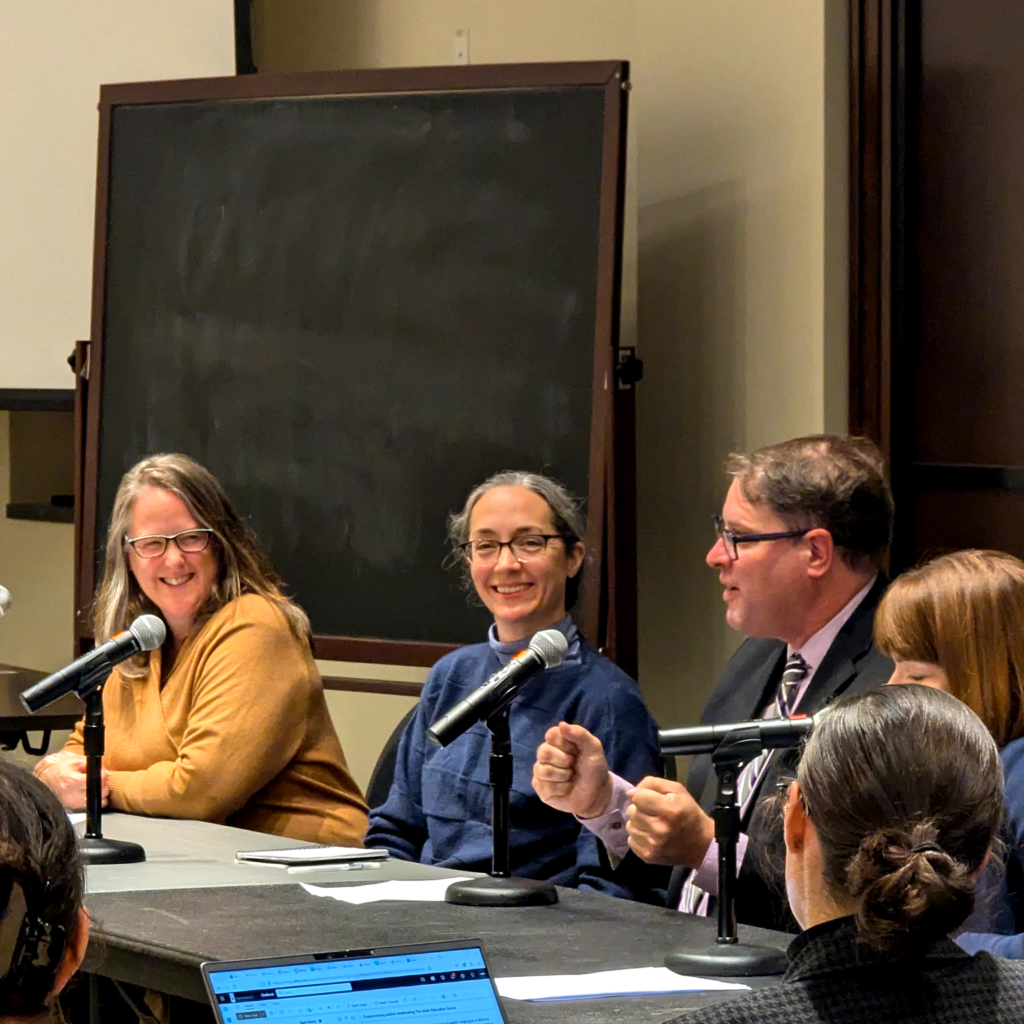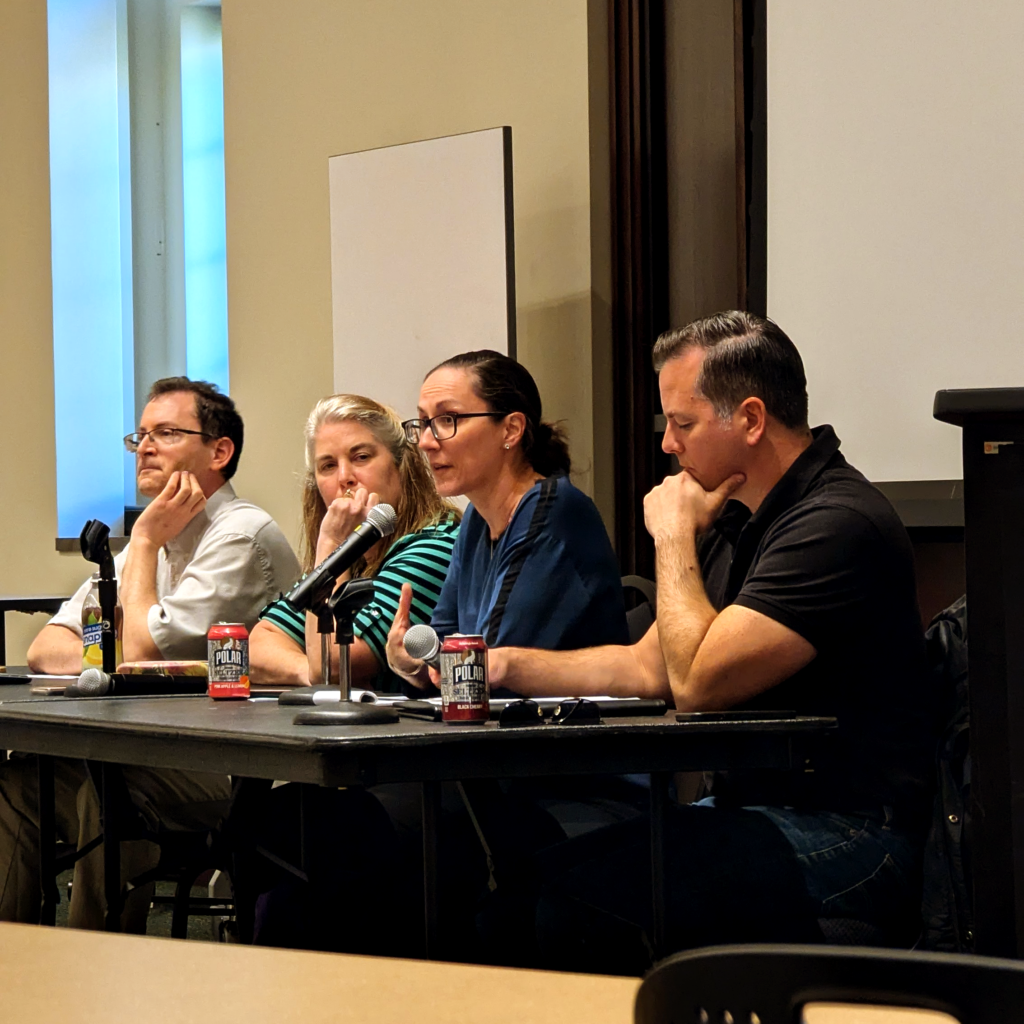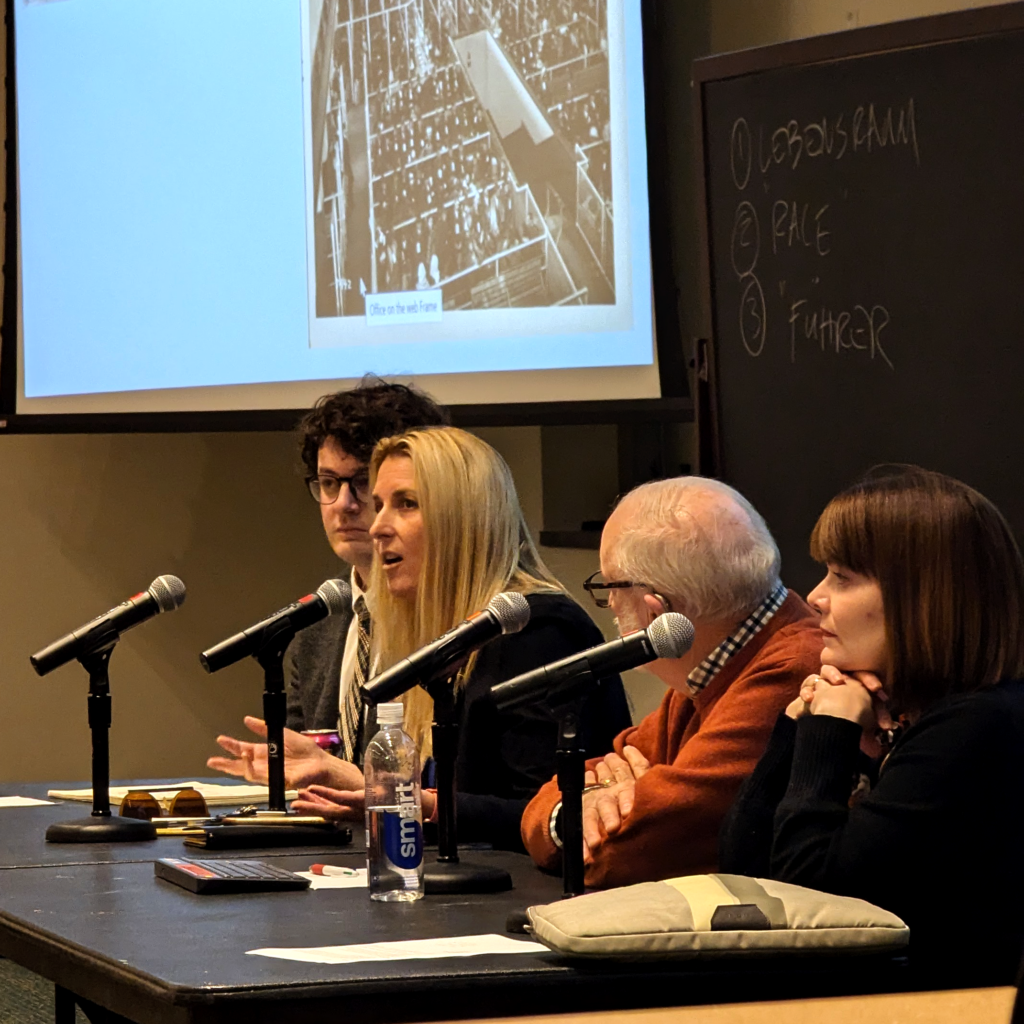The Voter Education Series
In the wise words of Aaron Sorkin via Will McAvoy, “There’s nothing that’s more important in a democracy than a well-informed electorate.” With The West Wing and The Newsroom in mind, Dr. Rhiannon Miller worked with Dr. Adam Myers from the Department of Political Science to put on a series of three panels over the course of October to discuss different issues that would be on the ballot for the November 2024 Presidential Election. The three panels, Environmental Policy, Family Policy & the Economy, and Immigration, were tabled by several PC faculty from varying departments, and discussed and answered questions about a wide range of topics. Two of the panels, Environmental Policy and Immigration, were moderated by Dr. Margaret Watkins, Dean of the School of Arts and Sciences, while Dr. Brandon Martinez moderated the Family Policy & the Economy panel.

Environmental Policy
Dr. Maia Bailey (Biology), Dr. Charlotte Roberts (Sociology & Anthropology), and Dr. Casey Stevens (Political Science) were the panelists for the Environmental Policy discussion.
(Photo; Left to Right: Drs. Maia Bailey, Charlotte Roberts, Casey Stevens, and Margaret Watkins)
Dr. Roberts spoke extensively on Per- and polyfluoroalkyl substances (PFAS), also known as forever chemicals, and the approach that the Harris and Trump Administrations might adopt in dealing with the economical, environmental, and health effects of these chemicals. In terms of the differing approaches between the current Biden Administration and a Trump Administration, one of the more noticeable policy changes would be in how each administration choses to utilize the Environmental Protection Agency (EPA) in the study of PFAS. Under the Biden Administration, the EPA breaks down the ~15,000 different PFA chemical into subclasses of 50 to 100, studies those subclasses, and then creates a rule for that subclass. Under a Trump Administration, Project 2025 proposes that the EPA study each PFAS chemical individually, and then create an individual rule for that chemical. Dr. Roberts spoke to the potential negative side effects of this second proposed regulatory method for the EPA to institute, saying that scientists will spend “a couple of years of crunching the data, aggregating it, coming up with a rule measuring costs and benefits for each one. And then saying, okay, you can’t use this one. Well, by the time they get through that process, chemical researchers will have created five more PFAS varieties, [making it] impossible to actually manage the risks associated with these chemicals.“
Dr. Bailey took a moment to discuss the recent Supreme Court decision to strike down the 1984 Chevron Doctrine earlier in June of this year, reversing the 40-year-old policy that required companies to treat the EPA as the expert on how policies concerning chemicals and pollutants should be enforced. The Supreme Court’s June 2024 Loper Decision states that the industry is able to decided, to some degree, how policies should be enforced by reading the policy and deciding whether or not they themselves meet those standards.1 Dr. Bailey noted the complications that inherently come with allowing the industry to regulate itself, saying that “you can see right there that the companies had a self-interest in interpreting policies much more restrictively than the EPA would.“
Segueing from the domestic into the international level, Dr. Stevens spoke to the global plastics treaty that was to be negotiated at a meeting of 3,300 delegates from 175 different counties this November in Busan, South Korea. The negotiating table had been divided, as Dr. Stevens described it, into two different camps; the European Union and Peru pushing for limitations on plastic production, and China and Saudi Arabia pushing for no limitations on plastic production, nor a list of potentially restricted and/ or banned chemicals. Dr. Stevens also noted that the outcome of the November 2024 Presidential election would greatly influence how successful the plastics treaty negotiations would be; a Trump Administration is expected have an opinion that more closely mirrors the Chinese and Saudi Arabian camp, and this election outcome would very likely lead to the purposeful delay in any treaty negotiations until Former President Trump could come to the table. Conversely, a Harris Administration would likely influence the Chinese and Saudi Arabian camp to adopt a policy that aligns with the Biden Administration’s current policy, which strongly favors capping plastic production.
UPDATE: At the fifth session of the United Nations’ Intergovernmental Negotiating Committee on Plastic Pollution (INC-5) from November 25 to December 1, the delegates were unable to negotiate a global plastics treaty.2 An additional session, “INC-5.2” has been scheduled in 2025.

Family Policy & The Economy
Dr. Adam Myers (Political Science), Dr. Sharon Murphy (History & Classics), Dr. Rhiannon Miller (Sociology & Anthropology) were the panelists for the Family Policy & The Economy discussion. (Photo; Left to Right: Drs. Adam Myers, Sharon Murphy, Rhiannon Miller, and Brandon Martinez)
Dr. Brandon Martinez (Sociology & Anthropology), moderator for the panel, started off the discussion by asking the panelists to discuss what they consider to be one of the most pressing issues of the time. Dr. Myers identified house affordability as a short-term issue, explaining that while in previous years house affordability was a problem seen mostly in large metropolitan areas on the coast, it was now a problem that cities and towns across the country faced, regardless of location. Dr. Myers also spoke to new technological innovations as a long-term issue the country would be forced to deal with, specifically highlighting the use of Artificial Intelligence and Biotech. Another topic that Dr. Myers mentioned was the Tax Cut and Jobs Act, a tax cut passed by the Trump Administration in 2017 and resulted in a reduction in top tax rates for “nearly all Americans, [but] the biggest part of the tax cut was toward the upper end of the income scale.” Where a Harris Administration would likely roll back some of these tax cuts – particularly those on the highest income earners – to prevent a larger national debt crisis, a Trump Administration would likely make the 2017 tax cuts permanent.
Drs. Murphy and Miller both spoke to income and wealth inequality as primary issues facing Americans today, with Dr. Murphy noting that it is because of wealth inequality that many Americans have a skewed view of how well the economy is doing; “Whereas the economy as a whole is doing really well in so many areas, not everybody is feeling it because of [the] wage stagnation that’s going on.” Another aspect that is tied into the perception of the economy is the perception of inflation. (As a quick review, Dr. Murphy explained that inflation is when the [quantity] that any given dollar bill can buy becomes less, i.e. when you can buy less with your money). As far as how inflation looks in the United States, Dr. Murphy said that is not nearly as bad as the general public thinks it is, and is also not a problem unique to the United States. Disrupted supply chains due to the COVID-19 pandemic and the war in Ukraine caused prices to rise on a global scale, and while it may seem like policies within the United States have exacerbated this inflation, global economies are recovering much more slowly than the United States.
While it may be factually accurate that inflation is not as high as the American people feel it is, Dr. Miller raised the important point that most Americans “don’t think like social scientists when they’re going to the voting booth […] They’re not thinking about things across the course of history or looking at their relative income according to a graph. […] They’re thinking about right now, this is how my paycheck is going.” As a sociologist that primarily studies equality, family, and gender, Dr. Miller brought up issues connected to early childhood and the support, or lack thereof, that families with young children receive; “We kind of have this disconnect in terms of what we’re expecting from parents and what we’re putting on parents in order to prepare their children to enter later parts of society. And that’s why we see things like the child tax credit, parental leave, and [people] talking about universal pre-K in the election.” This conversation surrounding childcare, education, and parental and caregiver support is a complex one, and one that Dr. Miller says was made even more important in the wake of the pandemic, when the general public’s perception of the role of schools changed drastically. The pandemic also brought about a reassessment of the typical model of childcare, the “Breadwinner” model, which relies on one parent that goes to work and one parent that stays at home to take care of house and, theoretically, children. It is from this acknowledgement of the failing Breadwinner model that an increased emphasis on institutionalizing economic supports for parents and caregivers grew. These economic supports, as Dr. Miller said, allow the responsibility of childcare to be shared by the community and country as a whole and acts as an “investment” of sorts for current and future generations; “When we talk about these […] subsidies. You could call them supports, you can call them tax breaks for young families. Really, they’re bringing to the forefront this question or this idea of what responsibility do we have as a society as a country, as a collective, to support the youngest members of our society that are then going to need to be able to grow up and age into fulfilling their social roles that will support us.“

Immigration
Dr. Robert Hasson (Social Work), Dr. Kara Cebulko (Sociology & Anthropology), and Dr. Richard Grace (History & Classics) were the panelists for the third and final discussion, Immigration. (Photo; Left to Right: Drs. Robert Hasson, Kara Cebulko, Richard Grace, and Margaret Watkins.)
The panel began with a historical background for current issues and conversations surrounding immigration and immigrant communities, with Dr. Cebulko making direct correlations between immigrant communities in the 1800s and today; “Some of the things you may have heard is that [Haitian immigrants are ] taking jobs, […] they refuse to assimilate, and they’re here illegally. And the striking piece of this [is], if you just took that rhetoric without putting Haitians in Springfield and put it into the 1880s, you might be talking about the Chinese immigrants. If you look at the 1850s, you might be taking about the Irish immigrants. You look at 1690, and it was German [immigrants].” It is through considering historical contexts in conjunction with present immigration trends and data, Dr. Cebulko explained, that we can better understand the circumstances that lead people to choose to leave their homes and come to the United States. Dr. Grace also spoke to the long history of immigration in the United States, comparing post-World War II and pre-COVID-19 pandemic figures. Following WWII, there were roughly 40 million refugees in the world, many of which were in Europe. In 2019, the United Nations estimated that there were 70 million refugees in the world, an increase that Dr. Grace described as “staggering“.3
The panel also discussed other aspects of how immigration is perceived in the United States, pushing back against false narratives such as the belief that “immigrants are a drain on the economy”. Dr. Hasson stated that the relationship between the U.S. economy and immigrants is actually quite different, and that there is a “growing body of evidence that immigrants [..] are making market contributions to the economy [through] different forms of taxes, going out to eat and shop, and going into the community to purchase things.” Dr. Cebulko also explained how this net positive translates into the workforce, as the economy expands and creates a new job for every new immigrant, allowing for a greater increase in job promotions for existing workers. Using an analogy that she said she often uses in class, Dr. Cebulko explained that seeing a correlation between an influx of immigration and low wages is about as ridiculous as seeing a correlation between the number of people who die to the number of people who eat ice cream in a given day; “When you see immigrants come in [and] wages going down for low wage workers, it doesn’t mean that the ice cream or the immigrants come in is causing death or low wages. There’s something else going on and in the case of the ice cream and the deaths, it has to do with heat – when it’s hot outside, both things happen [..] there is something else happening that’s dragging down wages for both groups, and it doesn’t have to do with the immigrants coming in.“
As we move forward into January 2025 with the upcoming Presidential Administration, we will keep Dr. Hasson’s words on the role of a social worker in the immigration field in mind; “Dignity and worth of a person is one of [social work’s] values. Not dignity and worth of the citizen, not dignity and worth of a Democrat or a Republican, but the dignity and worth of a person, making sure that families have an opportunity to thrive together [and] to flourish together in communities.“
- Loper Bright Enterprises ET AL. v. Raimondo, Secretary of Commerce, ET AL., No. 22–451, 603 U.S. __ (2024). ↩︎
- Jennifer McDermott, “Negotiators fail to reach an agreement on a plastic pollution treaty. Talks to resume next year,” Climate, Associated Press, December 2, 2024, https://apnews.com/article/plastic-pollution-treaty-south-korea-75187319a8cebc6e54fc1557ff40b266 ↩︎
- The United Nations High Commissioner for Refugees, “Worldwide displacement tops 70 million, UN Refugee Chief urges greater solidarity in response,” news release, June 19, 2019. ↩︎





